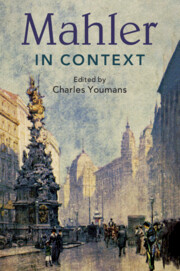Book contents
- Mahler in Context
- Composers in Context
- Mahler in Context
- Copyright page
- Dedication
- Contents
- Figures
- Music Examples
- Notes on Contributors
- Preface and Acknowledgments
- Abbreviations
- Part I Formation
- Chapter 1 Family Life
- Chapter 2 A Childhood in Bohemia
- Chapter 3 Music in Iglau, 1860–1875
- Chapter 4 Student Culture in 1870s Vienna
- Chapter 5 Viennese Musical Associates, 1875–1883
- Chapter 6 Becoming a Conductor
- Chapter 7 Between “Thrice Homeless” and “To the Germans in Austria”
- Part II Performance
- Part III Creation
- Part IV Mind, Body, Spirit
- Part V Influence
- Further Reading
- Index
Chapter 3 - Music in Iglau, 1860–1875
from Part I - Formation
Published online by Cambridge University Press: 18 December 2020
- Mahler in Context
- Composers in Context
- Mahler in Context
- Copyright page
- Dedication
- Contents
- Figures
- Music Examples
- Notes on Contributors
- Preface and Acknowledgments
- Abbreviations
- Part I Formation
- Chapter 1 Family Life
- Chapter 2 A Childhood in Bohemia
- Chapter 3 Music in Iglau, 1860–1875
- Chapter 4 Student Culture in 1870s Vienna
- Chapter 5 Viennese Musical Associates, 1875–1883
- Chapter 6 Becoming a Conductor
- Chapter 7 Between “Thrice Homeless” and “To the Germans in Austria”
- Part II Performance
- Part III Creation
- Part IV Mind, Body, Spirit
- Part V Influence
- Further Reading
- Index
Summary
Mahler’s youth in Iglau exposed him to a rich variety of music, much of it originating outside the symphonic and operatic traditions that eventually would occupy him professionally and creatively. The enclave’s provincial location and ethnic diversity gave rise to a singular mixture of folk music traditions. The garrison’s military bands made varied contributions to the city’s everyday sounds and musical life. And as a bastion of German liberalism, Iglau sustained many social, sacred, and municipal organizations that promoted the cultivation and performance of music. This chapter examines these repertories (fiddle music, folk song, rustic dances; military band repertoire, including dances, tunes from operettas, and original works for the ensemble; and music for choral societies and community bands), along with the institutions and performance circumstances that supported them, illuminating sources from which Mahler appropriated materials vitally important to his idiosyncratic compositional voice.
- Type
- Chapter
- Information
- Mahler in Context , pp. 22 - 31Publisher: Cambridge University PressPrint publication year: 2020

